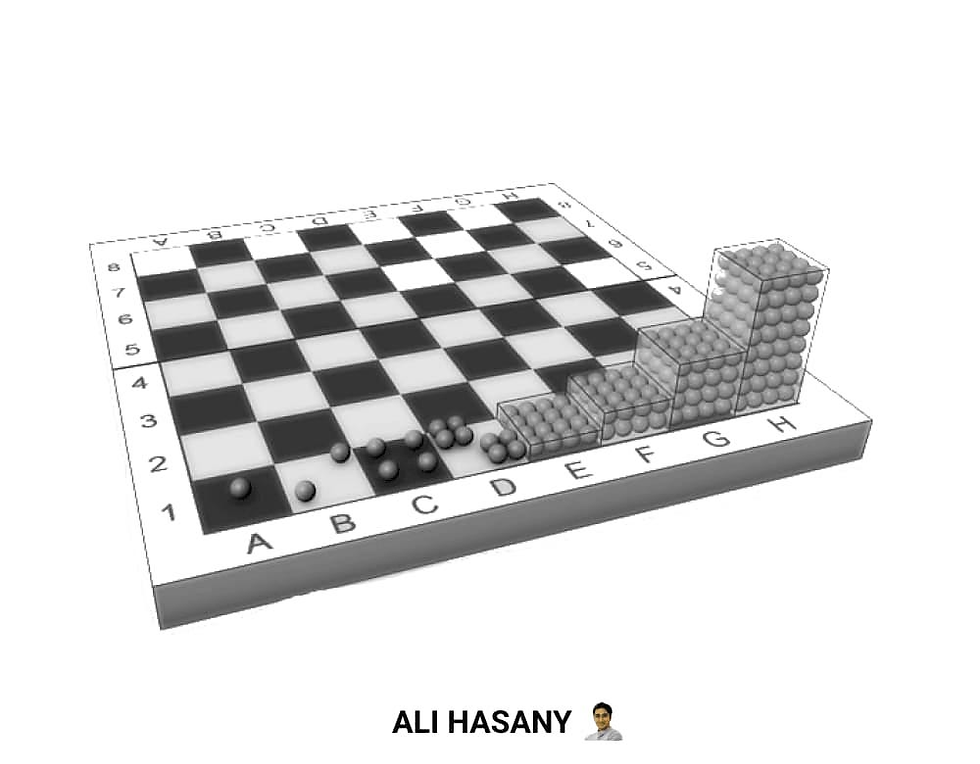EXPONENTIAL — Story of Chess and Rice
- Ali Hasany

- Sep 7
- 3 min read
Once upon a time in ancient India.
A man came to the palace of the King. He was an inventor who presented a game to the king called “Chess”.
The king was impressed with the beauty and sobriety of the game. He wanted to reward the inventor for his amazing work.
He asked the inventor:
“What would you prefer as a prize? You can have anything you want in my kingdom if you name it.”
The inventor made a simple request:
“Dear Majesty, I need my reward in the following manner. Place one grain of rice in the first square, two in the second, four in the third, and so forth. Doubling the number of rice grains on each succeeding square.”
The king was surprised. Instead of asking for Gold and Silver, he wondered for a few rice grains.
He misunderstood the intentions of Inventory, who was a wise mathematician.
Even though the request seemed small, the king was not very impressed. Still, he ordered his treasury to give rice as per the way asked by the inventor.
The King’s servants placed grains of rice on a chessboard square by square as per the inventor’s idea.

When they reached the 8th square, they had already placed 128 grains of rice — a small handful! But they didn’t realize how quickly the number of grains would grow. (This is the exponential growth’s misleading phase.)
By the 32nd square, there were so many grains — 2.1 billion(equal to 10,000 kilograms)! It was too much to fit on the board.
By the 64th square, there was more rice than anyone could count — enough to make a mountain as big as Everest!
This story is a Rice and chess problem. It is also narrated with the Rice and Wheat problem in some literature.
As per historians, King ordered to kill the inventor. He was not happy to find this out.
Back then, people didn’t have calculators or computers to do big number calculations.
We can stop the story here.
Power of Exponential
How we use Exponential in modern life.
Refer to Wikipedia for technical.
“Simple addition can solve the problem. With 64 squares on a chessboard, if the number of grains doubles on successive squares, then the sum of grains on all 64 squares is: 1 + 2 + 4 + 8 + … and so forth for the 64 squares.
An exponential function is the power of a number multiplied by the number itself.
To understand number growth in this manner is tricky.
We all think linear; if you go 10 meters in a straight line, you will be across the room.
We can all imagine where you will be in 20 or 30 linear steps with amazing accuracy.
But predicting exponential growth is not logical and generally surprises and disrupts us.
If you take 30 big steps by doubling each time (1, 2, 4, 8, 16, 32), you won’t go 30 meters. Instead, you will go around the world 26 times and end up a billion meters away!
In simple terms,
If you double something 10 times will make it 1,000 times bigger.
If you double something 20 times will make it 1,000,000 times bigger.
If you double something 30 times will make it 1,000,000,000 times bigger.

We are seeing that AI is moving faster than human intelligence. Due to exponential functions.
“The greatest shortcoming of the human race is our inability to understand the exponential function.” — Albert Allen Bartlett
Three Top Examples of Exponentials:
CHATGPT
A type of Generative AI is the best example of an exponential technology. It takes Linear Input as Prompt from Humans, but Processing is Exponential.
Quantum computers
They can solve hard problems faster than regular computers due to exponentials. They can help in many areas, like keeping information safe and making new materials.
Banking
In banks, money grows over time because of something called compound interest. An example of the exponential function. This means the money you save or owe increases faster and faster!
Conclusion
Closing on the quote from Bill Gates, which explains exponential computing.
“If General Motors had kept up with the technology like the computer industry has, we would all be driving $25.00 cars that got 1,000 miles to the gallon.” — Bill Gates
Stay tuned next time.


Comments